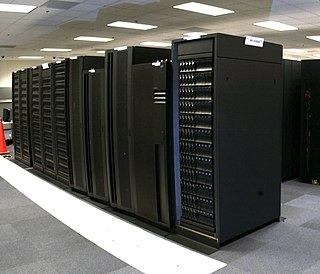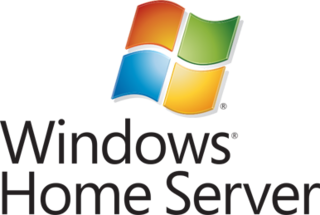Related Research Articles

Network-attached storage (NAS) is a file-level computer data storage server connected to a computer network providing data access to a heterogeneous group of clients. The term "NAS" can refer to both the technology and systems involved, or a specialized device built for such functionality.
In information technology, a backup, or data backup is a copy of computer data taken and stored elsewhere so that it may be used to restore the original after a data loss event. The verb form, referring to the process of doing so, is "back up", whereas the noun and adjective form is "backup". Backups can be used to recover data after its loss from data deletion or corruption, or to recover data from an earlier time. Backups provide a simple form of disaster recovery; however not all backup systems are able to reconstitute a computer system or other complex configuration such as a computer cluster, active directory server, or database server.
NetApp, Inc. is an intelligent data infrastructure company that provides unified data storage, integrated data services, and cloud operations (CloudOps) solutions to enterprise customers. The company is based in San Jose, California. It has ranked in the Fortune 500 from 2012 to 2021. Founded in 1992 with an initial public offering in 1995, NetApp offers cloud data services for management of applications and data both online and physically.
Filesystem in Userspace (FUSE) is a software interface for Unix and Unix-like computer operating systems that lets non-privileged users create their own file systems without editing kernel code. This is achieved by running file system code in user space while the FUSE module provides only a bridge to the actual kernel interfaces.
A file-hosting service, also known as cloud-storage service, online file-storage provider, or cyberlocker, is an internet hosting service specifically designed to host user files. These services allow users to upload files that can be accessed over the internet after providing a username and password or other authentication. Typically, file hosting services allow HTTP access, and in some cases, FTP access. Other related services include content-displaying hosting services, virtual storage, and remote backup solutions.
Continuous data protection (CDP), also called continuous backup or real-time backup, refers to backup of computer data by automatically saving a copy of every change made to that data, essentially capturing every version of the data that the user saves. In its true form it allows the user or administrator to restore data to any point in time. The technique was patented by British entrepreneur Pete Malcolm in 1989 as "a backup system in which a copy [editor's emphasis] of every change made to a storage medium is recorded as the change occurs [editor's emphasis]."
IBM Storage Protect is a data protection platform that gives enterprises a single point of control and administration for backup and recovery. It is the flagship product in the IBM Spectrum Protect family.
Veritas Backup Exec is a data protection software product designed for customers with mixed physical and virtual environments, and who are moving to public cloud services. Supported platforms include VMware and Hyper-V virtualization, Windows and Linux operating systems, Amazon S3, Microsoft Azure and Google Cloud Storage, among others. All management and configuration operations are performed with a single user interface. Backup Exec also provides integrated deduplication, replication, and disaster recovery capabilities and helps to manage multiple backup servers or multi-drive tape loaders.
In computer science, storage virtualization is "the process of presenting a logical view of the physical storage resources to" a host computer system, "treating all storage media in the enterprise as a single pool of storage."
In computing, off-site data protection, or vaulting, is the strategy of sending critical data out of the main location as part of a disaster recovery plan. Data is usually transported off-site using removable storage media such as magnetic tape or optical storage. Data can also be sent electronically via a remote backup service, which is known as electronic vaulting or e-vaulting. Sending backups off-site ensures systems and servers can be reloaded with the latest data in the event of a disaster, accidental error, or system crash. Sending backups off-site also ensures that there is a copy of pertinent data that is not stored on-site.

The IBM Storage product portfolio includes disk, flash, tape, NAS storage products, storage software and services. IBM's approach is to focus on data management.

Windows Home Server is a home server operating system from Microsoft. It was announced on 7 January 2007 at the Consumer Electronics Show by Bill Gates, released to manufacturing on 16 July 2007 and officially released on 4 November 2007.
Cloud storage is a model of computer data storage in which data, said to be on "the cloud", is stored remotely in logical pools and is accessible to users over a network, typically the Internet. The physical storage spans multiple servers, and the physical environment is typically owned and managed by a cloud computing provider. These cloud storage providers are responsible for keeping the data available and accessible, and the physical environment secured, protected, and running. People and organizations buy or lease storage capacity from the providers to store user, organization, or application data.
This is a comparison of online backup services.
Carbonite, Inc. is an American company that offers an online backup service, available to Windows and macOS users. In 2019 it was acquired by Canadian software company OpenText. It backs up documents, e-mails, music, photos, and settings. It is named after carbonite, the fictional substance used to freeze Han Solo in Star Wars: The Empire Strikes Back. Carbonite was the first such service to offer unlimited backup space for a fixed price. Previously, all online backup services were priced by the gigabyte; many other vendors have since changed to an unlimited model.
Commvault Systems, Inc. is an American publicly traded data protection and data management software company headquartered in Tinton Falls, New Jersey. Commvault enterprise software can be used for data backup and recovery, cloud and infrastructure management, retention and compliance.

IDrive Inc. is a technology company that specializes in data backup applications. Its flagship product is IDrive, an online backup service available to Windows, Mac, Linux, iOS and Android users.

Veeam Backup & Replication is a proprietary backup app developed by Veeam for virtual environments built on VMware vSphere, Nutanix AHV, and Microsoft Hyper-V hypervisors. The software provides backup, restore and replication functionality for virtual machines, physical servers and workstations as well as cloud-based workload.

MSP360, formerly CloudBerry Lab, is a software and application service provider company that develops online backup, remote desktop and file management products integrated with more than 20 cloud storage providers.
ONTAP or Data ONTAP or Clustered Data ONTAP (cDOT) or Data ONTAP 7-Mode is NetApp's proprietary operating system used in storage disk arrays such as NetApp FAS and AFF, ONTAP Select, and Cloud Volumes ONTAP. With the release of version 9.0, NetApp decided to simplify the Data ONTAP name and removed the word "Data" from it, removed the 7-Mode image, therefore, ONTAP 9 is the successor of Clustered Data ONTAP 8.
References
- ↑ Vendor Landscape Storyboard: Cloud Backup. InfoTech Research Group Research, July 2011. p. 4
- ↑ Martin Taylor (May 2012). "Cloud backup options: Pure cloud vs hybrid cloud backup". computerweekly.com. TechTarget. Retrieved 3 September 2015.
- ↑ Boles, Jeff. Hybrid cloud backup: D2D2C emerging as a viable data backup strategy. SearchDataBackup, 2 May 2011
- ↑ Slack, Eric. "Does Cloud Backup Need An Appliance?" Storage Switzerland, 14 June 2012
- ↑ Whitehouse, Lauren. "The pros and cons of cloud backup technologies” SearchDataBackup, March 2009
- ↑ “Backup as a service FAQ” SearchSMBStorage, October 2008
- ↑ Scheduled backups of SQL Server or SQL Server Express databases (without version limitation)..
- ↑ Zaborszky, Peter. (16 November 2012) Are online backups worth it? How much are you paying per GB at home?. Best Backups.com. Retrieved on 2013-08-10.